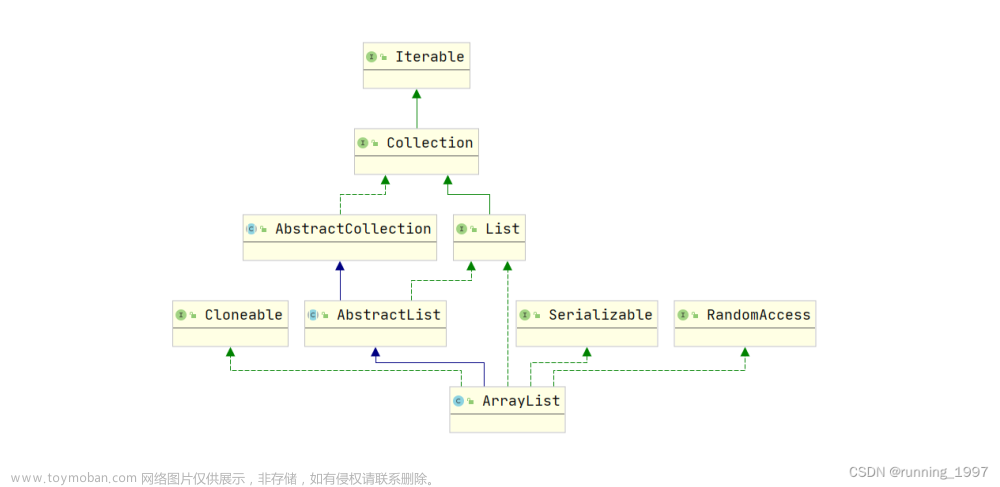目录
一、ArrayList类定义
二、ArrayList类与数组的区别
三、ArrayList类对象的声明
1、默认的构造器
2、用一个ICollection对象来构造
3、用指定的大小初始化内部的数组
四、ArrayList常用属性
五、ArrayList常用方法
1、ArrayList元素的添加
(1)Add()方法
(2)Insert()方法
(3)综合例
2、ArrayList元素的删除
(1)Clear()方法
(2)Remove()方法
(3)RemoveAt()方法
(4)RemoveRange()方法
(5)综合例
3、ArrayList元素的查找
(1)Contains()方法
(2)IndexOf()方法
(3)LastIndexOf()方法
4、ArrayList的遍历
一、ArrayList类定义
ArrayList类相当于一种高级的动态数组,它是Array类的升级版本。
ArrayList类位于System.Collections命名空间下,它可以动态地添加和删除元素。可以将ArrayList类看作扩充了功能的数组,但它并不等同于数组。使用ArrayList类要添加引用:
using System.Collections;
二、ArrayList类与数组的区别
与数组相比,ArrayList类为开发人员提供了以下功能。
☑ 数组的容量是固定的,而ArrayList的容量可以根据需要自动扩充。
☑ ArrayList提供添加、删除和插入某一范围元素的方法,但在数组中,只能一次获取或设置一个元素的值。
☑ ArrayList提供将只读和固定大小包装返回集合的方法,而数组不提供。
☑ ArrayList只能是一维形式,而数组可以是多维的。
Array的长度是它可包含的元素总数。Array的秩是Array中的维数。Array中维度的下限是Array中该维度的起始索引,多维Array的各个维度可以有不同的界限。
三、ArrayList类对象的声明
ArrayList提供了3个构造器,通过这3个构造器可以有3种声明方式:
1、默认的构造器
以默认(16位)的大小来初始化内部的数组。
构造器格式:public ArrayList();
通过以上构造器声明ArrayList的语法格式:
ArrayList List=new(); //List:ArrayList对象名。
ArrayList List=new(); //List:ArrayList对象名
for(i=0;i<10;i++) //给ArrayList类对象添加10个int型元素
{
List.Add(i);
}2、用一个ICollection对象来构造
并将该集合的元素添加到ArrayList中。
构造器格式:public ArrayList(ICollection);
通过以上构造器声明ArrayList的语法格式:
ArrayList List=new( arrayName);
☑ List:ArrayList对象名。
☑ arryName:要添加集合的数组名。
int[]arr=new int[]{1,2,3,4,5,6,7,8,9};
ArrayList List=new(arr);3、用指定的大小初始化内部的数组
构造器格式:public ArrayList(int);
通过以上构造器声明ArrayList的语法格式:
ArrayList List=new(n);
☑ List:ArrayList对象名。
☑ n:ArrayList对象的空间大小。
ArrayList List=new(10);
for(int i=0;i<List.Count;i++)
{
List.Add(i); //给ArrayList添加10个int型元素
}四、ArrayList常用属性
| 属性 |
说明 |
| Capacity |
获取或设置ArrayList可包含的元素数 |
| Count |
获取ArrayList实际包含的元素数 |
| IsFixedSize |
获取一个值,该值指示ArrayList是否具有固定的大小 |
| IsReadOnly |
获取一个值,该值指示ArrayList是否为只读 |
| IsSyncronized |
获取一个值,该值指示是否对ArrayList同步访问 |
| Item |
获取或设置指定索引处的元素 |
| SyncRoot |
获取可用于同步ArrayList访问的对象 |
五、ArrayList常用方法
1、ArrayList元素的添加
(1)Add()方法
Add()方法用来将对象添加到ArrayList集合的结尾处,其语法格式:
public virtual int Add(Object value);
☑ value:要添加到ArrayList的末尾处的Object,该值可以为空引用。
☑ 返回值:ArrayList索引,已在此处添加了value。
ArrayList允许null值作为有效值,并且允许重复的元素。
int arr[] =new int[]{1,2,3,4,5,6};
ArrayList List = new (arr); //使用声明的数组实例化ArrayList对象
List.Add(7); //为ArrayList对象添加元素(2)Insert()方法
Insert()方法用来将元素插入ArrayList集合的指定索引处,其语法格式:
public virtual void Insert(int index, Object value)
☑ index:从零开始的索引,应在该位置插入value。
☑ value:要插入的Object,该值可以为空引用。
如果ArrayList实际存储元素数已经等于ArrayList可存储的元素数,则会通过自动重新分配内部数组增加ArrayList的容量,并在添加新元素之前将现有元素复制到新数组中。
int[] arr = new int[]{1,2,3,4,5,6};
ArrayList List = new(arr); //使用声明的数组实例化ArrayList对象
List.Insert(3,7); //在ArrayList对象索引值=3处添加元素7(3)综合例
//Add()方法和Insert()方法
//分别使用ArrayList对象的Add()方法和Insert()方法向ArrayList集合的结尾处和指定索引处添加元素
using System;
using System.Collections.Generic;
using System.Linq;
using System.Text;
using System.Collections;
namespace Test7_12
{
class Program
{
static void Main(string[] args)
{
if (args is null) //解除IDE0060
{
throw new ArgumentNullException(nameof(args));
}
int[] arr = new int[] { 1, 2, 3, 4, 5, 6 };
ArrayList List = new(arr); //使用声明的一维数组实例化一个ArrayList对象
Console.WriteLine("原ArrayList集合:");
foreach (int i in List) //遍历ArrayList源集合并输出
{
Console.Write(i + " ");
}
Console.WriteLine();
for (int i = 1; i < 5; i++)
{
List.Add(i + arr.Length); //使用Add()方法为ArrayList集合添加元素
}
Console.WriteLine("使用Add方法添加:");
foreach (int i in List) //遍历添加元素后的ArrayList集合并输出
{
Console.Write(i + " ");
}
Console.WriteLine();
List.Insert(6,0); //使用Insert()方法在ArrayList集合的index=6处添加元素0
Console.WriteLine("使用Insert方法添加:");
foreach (int i in List) //遍历最后的ArrayList集合并输出
{
Console.Write(i + " ");
}
Console.WriteLine();
Console.Read();
}
}
}
/*运行结果:
原ArrayList集合:
1 2 3 4 5 6
使用Add方法添加:
1 2 3 4 5 6 7 8 9 10
使用Insert方法添加:
1 2 3 4 5 6 0 7 8 9 10 */2、ArrayList元素的删除
(1)Clear()方法
Clear()方法用来从ArrayList中移除所有元素,其语法格式:
public virtual void Clear()
//使用 Clear()方法清除ArrayList中的所有元素
int[] arr = new int[]{1,2,3,4,5,6};
ArrayList List = new (arr); //使用声明的数组实例化ArrayList对象
List.Clear(); //在ArrayList对象指定位置添加元素(2)Remove()方法
Remove()方法用来从ArrayList中移除特定对象的第一个匹配项,其语法格式:
public virtual void Remove(Object obj)
obj:要从ArrayList移除的Object,该值可以为空引用。
在删除ArrayList中的元素时,如果不包含指定对象,则ArrayList将保持不变。
//使用RemoveAt()方法从声明的ArrayList对象中移除与3匹配的元素
int[] arr = new int[]{1,2,3,4,5,6};
ArrayList List = new(arr); //使用声明的数组实例化ArrayList对象
List.Remove(3); //删除ArrayList对象指定位置元素(3)RemoveAt()方法
RemoveAt()方法用来移除ArrayList的指定索引处的元素,其语法格式:
public virtual void RemoveAt(int index)
index:要移除的元素的从零开始的索引。
//使用RemoveAt()方法从声明的ArrayList对象中移除索引为3的元素
int[] arr = new int[]{1,2,3,4,5,6};
ArrayList List = newt(arr); //使用声明的数组实例化ArrayList对象
List.RemoveAt(3); //删除ArrayList对象指定位置元素(4)RemoveRange()方法
RemoveRange()方法用来从ArrayList中移除一定范围的元素,其语法格式:
public virtual void RemoveRange(int index,int count)
☑ index:要移除的元素的范围从零开始的起始索引。
☑ count:要移除的元素数。
在RemoveRange()方法中参数count的长度不能超出数组的总长度减去参数index的值。
//在ArrayList对象中使用RemoveRange()方法从索引3处删除两个元素
int[] arr = new int[]{1,2,3,4,5,6};
ArrayList List = new (arr); //使用声明的数组实例化ArrayList对象
List.RemoveRange(3,2); //删除ArrayList对象指定位置3处2个元素(5)综合例
//RemoveRange()
//使用RemoveRange()方法删除ArrayList集合中的一批元素
using System;
using System.Collections.Generic;
using System.Linq;
using System.Text;
using System.Collections;
namespace Test7_13
{
class Program
{
static void Main(string[] args)
{
if (args is null) //解除IDE0060
{
throw new ArgumentNullException(nameof(args));
}
int[] arr = new int[] { 1, 2, 3, 4, 5, 6, 7, 8, 9 };
ArrayList List = new(arr); //使用声明的一维数组实例化一个ArrayList对象
Console.WriteLine("原ArrayList集合:");
foreach (int i in List) //遍历ArrayList集合中的元素并输出
{
/*Console.Write(i+ " ");*/ //可以注释掉.ToString()不影响结果
Console.Write(i.ToString() + " ");
}
Console.WriteLine();
List.RemoveRange(0, 5); //从索引0处开始删除5个元素
Console.WriteLine("删除元素后的ArrayList集合:");
foreach (int i in List) //遍历删除元素后的ArrayList集合并输出其元素
{
Console.Write(i.ToString() + " ");
}
Console.WriteLine();
Console.Read();
}
}
}
/*运行结果:
原ArrayList集合:
1 2 3 4 5 6 7 8 9
删除元素后的ArrayList集合:
6 7 8 9 */3、ArrayList元素的查找
(1)Contains()方法
Contains()方法用来确定某元素是否在ArrayList集合中,其语法格式:
public virtual bool Contains(Object item)
☑ item:要在ArrayList中查找的Object,该值可以为空引用。
☑ 返回值:如果在ArrayList中找到item,则为true;否则为false。
//使用 Contains()方法判断数字2是否在ArrayList集合中
int[] arr = new int[]{1,2,3,4,5,6};
ArrayList List = new (arr); //使用声明的数组实例化ArrayList对象
Console.Write(List.Contains(2)); //ArrayList集合中是否包含指定的元素(2)IndexOf()方法
用于查找字符或者字符串首次出现的位置。
IndexOf() 方法由以下语法表示:
public int IndexOf(String value); //语法1
public int IndexOf(char value); //语法2
public int IndexOf(String value, int startIndex); //语法3
public int IndexOf(char value, int startIndex); //语法4☑ value:指定要查找的字符或者字符串。
☑startIndex:指定要查找开始的位置。
返回字符或者字符串首次出现的位置,索引值从0开始计算。
//IndexOf()
//查找字符或者字符首次出现的位置
using System;
using System.Collections.Generic;
using System.Linq;
using System.Text;
namespace yxjc123
{
class Program
{
static void Main(string[] args)
{
if (args is null) //解除IDE0060
{
throw new ArgumentNullException(nameof(args));
}
string str = "yxjc123.com repeat yxjc123.com"; //原字符串
Console.WriteLine("查找j:" + str.IndexOf('j')); //查找字符j
Console.WriteLine("查找123:" + str.IndexOf("123")); //查找字符串123
Console.WriteLine("查找j:" + str.IndexOf('j', 10)); //查找字符j,从开始位置10开始
Console.WriteLine("查找123:" + str.IndexOf("123", 10)); //查找字符串123,从开始位置10开始
Console.ReadKey();
}
}
}
/*运行结果:
查找j:2
查找123:4
查找j:22
查找123:24 */(3)LastIndexOf()方法
用于查找字符或者字符串最后出现的位置。
LastIndexOf() 方法由以下语法表示:
public int LastIndexOf(String value); //语法1
public int LastIndexOf(char value); //语法2
public int LastIndexOf(String value, int startIndex); //语法3
public int LastIndexOf(char value, int startIndex); //语法4☑ value:指定要查找的字符或者字符串。
☑ startIndex:指定要查找开始的位置,从末尾开始计算。
返回字符或者字符串最后出现的位置。文章来源:https://www.toymoban.com/news/detail-731603.html
//LastIndexOf()
//用于查找字符或者字符串最后出现的位置
using System;
using System.Collections.Generic;
using System.Linq;
using System.Text;
namespace yxjc123
{
class Program
{
static void Main(string[] args)
{
if (args is null) //解除IDE0060
{
throw new ArgumentNullException(nameof(args));
}
string str = "yxjc123.com repeat yxjc123.com"; //原字符串
Console.WriteLine("查找j:" + str.LastIndexOf('j')); //查找字符j
Console.WriteLine("查找123:" + str.LastIndexOf("123")); //查找字符串123
Console.WriteLine("查找j:" + str.LastIndexOf('j', 10)); //查找字符j,倒数从开始位置10开始
Console.WriteLine("查找123:" + str.LastIndexOf("123", 10)); //查找字符串123,倒数从开始位置10开始
Console.ReadKey();
}
}
}
/*运行结果:
查找j:22
查找123:24
查找j:2
查找123:4 */4、ArrayList的遍历
ArrayList集合的遍历与数组类似,都可以使用foreach语句,下面通过一个实例说明如何遍历ArrayList集合中的元素。文章来源地址https://www.toymoban.com/news/detail-731603.html
//ArrayList的遍历
//使用foreach语句遍历ArrayList集合中的各个元素并输出
using System;
using System.Collections.Generic;
using System.Linq;
using System.Text;
using System.Collections;
namespace Test7_14
{
class Program
{
static void Main(string[] args)
{
if (args is null) //解除IDE0060
{
throw new ArgumentNullException(nameof(args));
}
ArrayList list = new() //实例化一个ArrayList对象并赋值
{
"TM",
"C#从入门到精通"
};
foreach (string str in list) //遍历ArrayList集合中的元素并输出
{
Console.WriteLine(str);
}
Console.ReadLine();
}
}
}
/*运行结果:
TM
C#从入门到精通 */到了这里,关于C#中的ArrayList类详解的文章就介绍完了。如果您还想了解更多内容,请在右上角搜索TOY模板网以前的文章或继续浏览下面的相关文章,希望大家以后多多支持TOY模板网!











